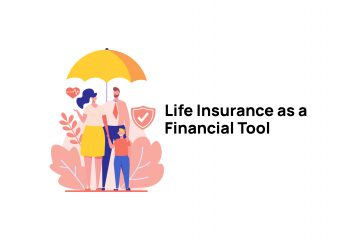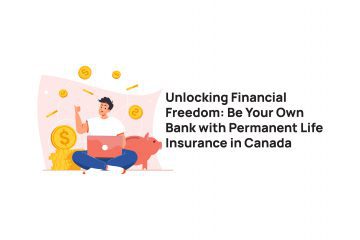Introduction
In the world of personal finance, the concept of “being your own bank” has gained popularity as individuals seek innovative ways to manage and grow their wealth. One strategy that has been gaining traction, especially in Canada, is utilizing permanent life insurance as a tool to achieve financial self-sufficiency.
In this comprehensive guide, we will take a deeper look into the intricacies of permanent life insurance and explore how it can empower Canadians to take control of their finances, ultimately allowing them to be their own bank.
In This Article:
- Understanding Permanent Life Insurance
- The Concept of “Being Your Own Bank”
- How to Implement the “Be Your Own Bank” Strategy
- Case Studies: Real-Life Examples of Success
- Common Misconceptions and Risks
- Conclusion: Empowering Financial Independence
Understanding Permanent Life Insurance
Before we dive into the concept of “being your own bank,” it’s crucial to understand the basics of permanent life insurance. Unlike term life insurance, which provides coverage for a specified term or period of time, permanent life insurance offers lifelong protection.
There are various types of permanent life insurance policies available in Canada, with the two most common being whole life insurance and universal life insurance.
A. Whole Life Insurance
Whole life insurance provides coverage for the entire life of the insured individual. Premiums remain level throughout the policyholder’s life, and a portion of each premium payment goes towards building cash value. This cash value grows over time on a tax-deferred basis, and policyholders can access it through policy loans or withdrawals. Policies can also have a death benefit which increases over time with the accumulation of paid up additions.
B. Universal Life Insurance
Universal life insurance offers more flexibility compared to whole life insurance. Policyholders have the option to adjust their premium payments and death benefits, providing a customizable approach to meet their changing needs. Similar to whole life insurance, universal life insurance policies have the ability accumulate cash value that can be accessed during the policyholder’s lifetime.

The Concept of “Being Your Own Bank”
The idea of “being your own bank” involves using permanent life insurance as a financial tool to achieve multiple objectives, such as wealth accumulation, tax advantages, and access to liquidity. This concept is based on the premise that, by leveraging the features of permanent life insurance, individuals can create a financial structure that mimics the functions of a traditional bank.
A. Wealth Accumulation
One of the primary benefits of permanent life insurance is its cash value component. As policyholders pay premiums, a portion of those payments goes into a cash value account, which is invested and accumulates over time. This cash value accumulation serves as a wealth-building mechanism, allowing individuals to accumulate funds that can be accessed later in life.
B. Tax Advantages
Permanent life insurance in Canada comes with unique tax advantages that make it an attractive option for those looking to optimize their financial strategy. The cash value growth within a life insurance policy is tax-deferred, meaning policyholders do not pay taxes on the gains as long as the funds remain within the policy. Additionally, death benefits paid to beneficiaries are tax free in Canada.
C. Access to Liquidity
The cash value in a permanent life insurance policy can be accessed through policy loans or withdrawals. This liquidity feature provides policyholders with a source of funds they can tap into during emergencies, opportunities, or retirement. The ability to access cash without triggering immediate tax consequences enhances the flexibility of the policy and contributes to the concept of being your own bank.
Get a free quote
How to Implement the “Be Your Own Bank” Strategy
Now that we understand the fundamentals of permanent life insurance and the concept of being your own bank, let’s explore the practical steps to implement this strategy effectively.
A. Selecting the Right Policy
Choosing the right type of permanent life insurance policy is crucial to the success of the “be your own bank” strategy. Whole life insurance and universal life insurance each have their advantages, and the decision should align with individual financial goals and preferences.
We highly recommend reaching out to us to speak with one of our agents who specialize in the area of permanent life insurance. With the amount of different policies available from multiple life insurance companies, it is worth a discussion to help determine which permanent life insurance policy is right for you. This is a long term strategy so it is imperative that you take your time to understand the offerings available in Canada.
B. Setting Premiums and Death Benefits
For universal life insurance, policyholders have the flexibility to adjust premium payments and death benefits. It’s essential to strike a balance that aligns with your financial capacity and long-term objectives. Working closely with one of our agents can help determine the optimal premium and death benefit levels.
C. Maximizing Cash Value Growth
To fully capitalize on the “be your own bank” strategy, it’s essential to focus on maximizing the cash value growth within the life insurance policy. This involves consistently paying premiums, leveraging additional funding options when available, and understanding the impact of policy loans and withdrawals on the cash value.
D. Utilizing Policy Loans Wisely
One of the key features of permanent life insurance is the ability to take out policy loans against the accumulated cash value. While policy loans provide access to liquidity, it’s crucial to use them judiciously. Interest accrues on policy loans, and unpaid loans can reduce the death benefit. Careful planning and consultation with one of our agents is essential to ensure optimal use of policy loans.
E. Monitoring and Adjusting the Strategy
Financial landscapes evolve, and personal circumstances change over time. Regularly reviewing and adjusting the “be your own bank” strategy is essential to ensure it remains aligned with your goals. Periodic assessments with a financial advisor can help identify opportunities for optimization and address any changing financial needs.
Case Studies: Real-Life Examples of Success
To illustrate the effectiveness of the “be your own bank” strategy, let’s explore a couple of hypothetical case studies highlighting how individuals in Canada have utilized permanent life insurance to achieve financial freedom.
Case Study 1: Wealth Accumulation and Legacy Planning
John, a 35-year-old professional in Canada, purchases a whole life insurance policy with the goal of building wealth and creating a legacy for his family. He chooses a policy with a level premium and death benefit, allowing him to consistently contribute to the cash value over the years. By the time John reaches retirement age, the cash value has grown significantly, providing him with a source of tax-free funds for supplemental income and legacy planning. He is able to access the cash value in the form of a policy loan or withdrawal. Choosing between the two options will depend on what he is trying to achieve.
Case Study 2: Retirement Income and Liquidity
Sarah, a 45-year-old business owner, opts for a universal life insurance policy that offers flexibility in premium payments and death benefits. Throughout her career, Sarah maximizes her premium payments and strategically uses policy loans during periods of financial opportunity. As she approaches retirement, Sarah leverages the accumulated cash value to supplement her retirement income, providing her with liquidity without relying solely on traditional retirement accounts.

Common Misconceptions and Risks
While the “be your own bank” strategy utilizing permanent life insurance can offer significant advantages, it’s essential to address common misconceptions and potential risks associated with this approach.
A. Misconception: Permanent Life Insurance is Only for the Wealthy
Contrary to popular belief, permanent life insurance is not exclusive to the wealthy. Individuals at various income levels can benefit from the wealth-building and tax advantages that these policies offer. The key is to tailor the policy to align with individual financial goals and capacities.
B. Misconception: High Premiums are Mandatory
While permanent life insurance requires ongoing premium payments, the misconception that these premiums must be exorbitant is false. Working with one of our agents to determine a manageable premium level that still allows for cash value growth is crucial.
C. Risk: Insufficient Understanding of Policy Features
One of the significant risks associated with permanent life insurance is a lack of understanding of the policy’s features and implications. Policyholders must be aware of how premium payments, cash value growth, and policy loans impact the overall performance of the policy. Seeking guidance from one of our life insurance agents is essential to mitigate this risk.
D. Risk: Economic and Interest Rate Factors
The performance of permanent life insurance policies can be influenced by economic conditions and interest rates. Fluctuations in the financial markets can impact the cash value growth and overall returns of the policy. Policyholders should be aware of these external factors and work with a financial professional to adjust their strategy accordingly.
Conclusion: Empowering Financial Independence
In conclusion, the “be your own bank” strategy using permanent life insurance in Canada is a powerful approach to achieving financial independence and security. By understanding the features of permanent life insurance, implementing the strategy effectively, and addressing common misconceptions and risks, individuals can create a financial structure that aligns with their long-term goals.
As with any financial strategy, seeking guidance from knowledgeable professionals is crucial to maximizing the benefits of permanent life insurance and unlocking the path to financial freedom.
Contact us today to learn more about the “be your own bank” strategy to see if it is right for you.




